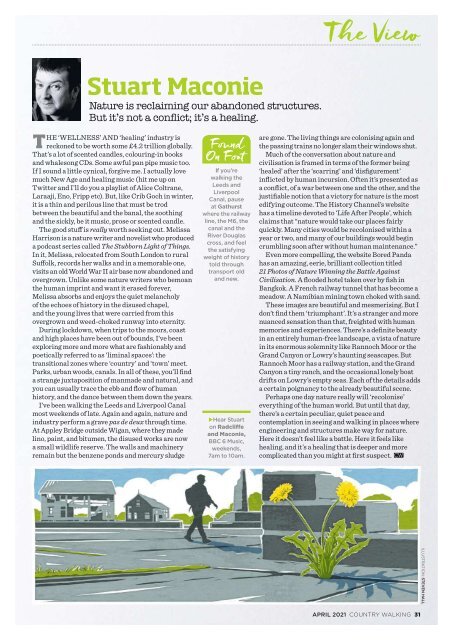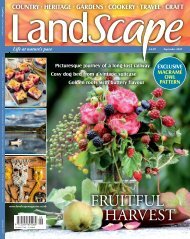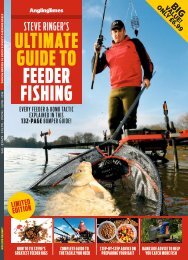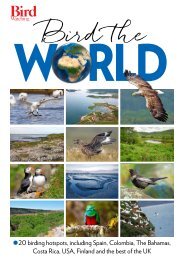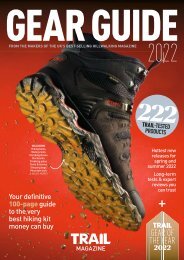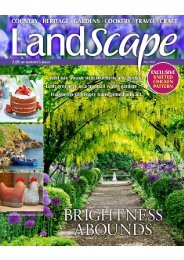Create successful ePaper yourself
Turn your PDF publications into a flip-book with our unique Google optimized e-Paper software.
Stuart Maconie<br />
Nature is reclaiming our abandoned structures.<br />
But it’s not a conflict; it’s a healing.<br />
THE ‘WELLNESS’ AND ‘healing’ industry is<br />
reckoned to be worth some £4.2 trillion globally.<br />
That’s a lot of scented candles, colouring-in books<br />
and whalesong CDs. Some awful pan pipe music too.<br />
If I sound a little cynical, forgive me. I actually love<br />
much New Age and healing music (hit me up on<br />
Twitter and I’ll do you a playlist of Alice Coltrane,<br />
Laraaji, Eno, Fripp etc). But, like Crib Goch in winter,<br />
it is a thin and perilous line that must be trod<br />
between the beautiful and the banal, the soothing<br />
and the sickly, be it music, prose or scented candle.<br />
The good stuff is really worth seeking out. Melissa<br />
Harrison is a nature writer and novelist who produced<br />
a podcast series called The Stubborn Light of Things.<br />
In it, Melissa, relocated from South London to rural<br />
Suffolk, records her walks and in a memorable one,<br />
visits an old World War II air base now abandoned and<br />
overgrown. Unlike some nature writers who bemoan<br />
the human imprint and want it erased forever,<br />
Melissa absorbs and enjoys the quiet melancholy<br />
of the echoes of history in the disused chapel,<br />
and the young lives that were carried from this<br />
overgrown and weed-choked runway into eternity.<br />
During lockdown, when trips to the moors, coast<br />
and high places have been out of bounds, I’ve been<br />
exploring more and more what are fashionably and<br />
poetically referred to as ‘liminal spaces’: the<br />
transitional zones where ‘country’ and ‘town’ meet.<br />
Parks, urban woods, canals. In all of these, you’ll find<br />
a strange juxtaposition of manmade and natural, and<br />
you can usually trace the ebb and flow of human<br />
history, and the dance between them down the years.<br />
I’ve been walking the Leeds and Liverpool Canal<br />
most weekends of late. Again and again, nature and<br />
industry perform a grave pas de deux through time.<br />
At Appley Bridge outside Wigan, where they made<br />
lino, paint, and bitumen, the disused works are now<br />
a small wildlife reserve. The walls and machinery<br />
remain but the benzene ponds and mercury sludge<br />
If you’re<br />
walking the<br />
Leeds and<br />
Liverpool<br />
Canal, pause<br />
at Gathurst<br />
where the railway<br />
line, the M6, the<br />
canal and the<br />
River Douglas<br />
cross, and feel<br />
the satisfying<br />
weight of history<br />
told through<br />
transport old<br />
and new.<br />
Hear Stuart<br />
on Radcliffe<br />
and Maconie,<br />
BBC 6 Music,<br />
weekends,<br />
7am to 10am.<br />
are gone. The living things are colonising again and<br />
the passing trains no longer slam their windows shut.<br />
Much of the conversation about nature and<br />
civilisation is framed in terms of the former being<br />
‘healed’ after the ‘scarring’ and ‘disfigurement’<br />
inflicted by human incursion. Often it’s presented as<br />
a conflict, of a war between one and the other, and the<br />
justifiable notion that a victory for nature is the most<br />
edifying outcome. The History Channel’s website<br />
has a timeline devoted to ‘Life After People’, which<br />
claims that “nature would take our places fairly<br />
quickly. Many cities would be recolonised within a<br />
year or two, and many of our buildings would begin<br />
crumbling soon after without human maintenance.”<br />
Even more compelling, the website Bored Panda<br />
has an amazing, eerie, brilliant collection titled<br />
21 Photos of Nature Winning the Battle Against<br />
Civilisation. A flooded hotel taken over by fish in<br />
Bangkok. A French railway tunnel that has become a<br />
meadow. A Namibian mining town choked with sand.<br />
These images are beautiful and mesmerising. But I<br />
don’t find them ‘triumphant’. It’s a stranger and more<br />
nuanced sensation than that, freighted with human<br />
memories and experiences. There’s a definite beauty<br />
in an entirely human-free landscape, a vista of nature<br />
in its enormous solemnity like Rannoch Moor or the<br />
Grand Canyon or Lowry’s haunting seascapes. But<br />
Rannoch Moor has a railway station, and the Grand<br />
Canyon a tiny ranch, and the occasional lonely boat<br />
drifts on Lowry’s empty seas. Each of the details adds<br />
a certain poignancy to the already beautiful scene.<br />
Perhaps one day nature really will ‘recolonise’<br />
everything of the human world. But until that day,<br />
there’s a certain peculiar, quiet peace and<br />
contemplation in seeing and walking in places where<br />
engineering and structures make way for nature.<br />
Here it doesn’t feel like a battle. Here it feels like<br />
healing, and it’s a healing that is deeper and more<br />
complicated than you might at first suspect.<br />
ILLUSTRATION: STEVEN HALL<br />
APRIL <strong>2021</strong> COUNTRY WALKING 31


